Royal County Down Golf Club
Co Down, Northern Ireland

County Down: the finest combination of beauty and challenge in golf.
Would Royal County Down be better or worse if it were built today on the same piece of land by any of the game’s living golf course architects? In the opinion of the author, the outcome would be more the latter than the former, which is ironic as part of the goal of this site is to highlight the resurgence in classic golf course architecture.
Yet, sadly, like The Old Course at St. Andrews, Royal County Down would never be re-created today. Even fans of Coore & Crenshaw and Tom Doak’s Renaissance Golf Design will admit their near steadfast aversion to blind tee balls. Holes like the 2nd, 5th, 6th, 9th, and 11th at County Down would likely not come into existence. More is the pity, especially as many of these are among the best holes on the course. A modern architect would either modify the dunescape or end up with a largely different routing, claiming that some of the features at County Down are anachronistic.
However, what for instance would be gained if the blind tee balls on the aforementioned holes were altered? What exactly is gained by ‘better’ visuals as defined by modern golf – anything of genuine substance? The author doubts it but certainly some of the uncertainty presented by County Down’s diversity of challenge would be undermined.
Also, some of its uniqueness would no doubt vanish. As with Oakmont Country Club and Pine Valley Golf Club, County Down stands apart as reminding one of no other course in the world in part because it was designed not by a professional architect but rather by strong willed people with a genuine love and feel for the game.
However, the first course at County Down does begin with Old Tom Morris who was hired for 4 guineas to build a championship course at Newcastle in 1890. His course started and finished by the railway station, which is to say that it played through the general area where the Slieve Donard Hotel now occupies. Many of the holes were on the grounds that the present day No. 1 and No. 2 courses at County Down occupy. However, as Old Tom Morris didn’t have the machinery at his disposal to move amounts of earth, he often stayed in the flatter areas of the No. 1 and No. 2 courses where it was easier to work.
In the extremely well researched centenary book Royal County Down Golf Club: The First Century by Harry McCaw and Brum Henderson (highly recommended and available at the office of The Royal County Down Golf Club), a map in the inside front jacket shows what must be Old Tom Morris’s routing. In the back, there is a map of the course in 1907, which bears little resemblance to Morris’s course. McGaw and Henderson credit member George Combe for much of the work and the general routing that the course now enjoys. An examination of this 1907 map shows that the 1st and 18th holes as three shotters and the 10th as a one shotter back away from the clubhouse have taken form. In addition, the 2nd, 3rd, 6th, 7th, 11th, 12th, 13th, 14th, and 15th general playing corridors of today were in use.
So the question is begged: who is George Combe? McGaw and Henderson answer by informing the reader that Combe was an excellent golfer with one of the first plus handicaps in the country. He took great interest in all aspects of the sport and among other things, found the Golfing Union of Ireland, started the handicapping GUI system that was latter largely adopted by the Royal & Ancient and was the instigator of the practice of the lining the hole with a metal tin.
When Combe began his work on the course in 1900, it measured approximately 5,150 yards. The advent of the rubber core Haskell ball was now upon us and by 1903, the course had grown to 6,400 yards. The basis of the course of today had emerged, with the vast majority of the credit deserved by Combe.
Much like Fownes at Oakmont, the autocratic Combe was never satisfied and continued to modify and improve on his work. By 1906, he made significant alterations to the playing corridors for what are today’s 11th, 12th and 13th holes.
Combe was made a honorary life member in 1909 and continued to make improvements to the course for several more years, many times at a cost out of his own pocket. Illness and then World War I saw the end of his quest for perfection.
In 1926, the Club brought Harry Colt to inspect the course with for the clear purpose of eliminating blind approach shots and for improving the challenge offered by the greens at County Down, many of which were gathering in nature.
Some people refer to County Down as a Harry Colt course. Such a reference is simply not accurate as Combe and other Club members deserve the lion share of the credit. However, Harry Colt‘s visit did yield perhaps the course’s two most famous holes are the 4th with its raised green and the 9th that plunges over the summit of a dune.

Colt created today’s one shot fourth hole in 1926. The raised green with its five foot swale left and back is one of the two or three finest green complexes on the course.
Prior to Colt, the 4th ran parallel the 3rd and played toward today’s 5th green as a 515 yard three shot hole, which meant the first one shotter didn’t occur until the 7th hole. Colt, ever with an eye for finding ideal one-shot holes, must have found today’s 4th without too much worry. A subsequent benefit was in the creation of the dogleg 5th, every bit the equal of the much admired 12th at Cypress Point which similarly plays over the shoulder of a dune.
Up ahead, today’s 9th was played as two holes prior to Harry Colt‘s visit. The first of those holes had a tee near today’s 1st green and the golfer “ with hickory clubs, mind you – had to scale the dune and play a long shot to a blind green. The next hole was a semi-blind 200 yarder. Harry Colt rerouted what is today’s 8th hole to stay atop the dune as opposed to returning back down near the 1st green. He then positioned the 9th tee whereby a cracking drive would clear the towering dune and fall down to the flat ground below. He lowered the dune that obscured the green and built today’s 9th green complex. In doing so, he created one of the game’s most photographed golf holes.
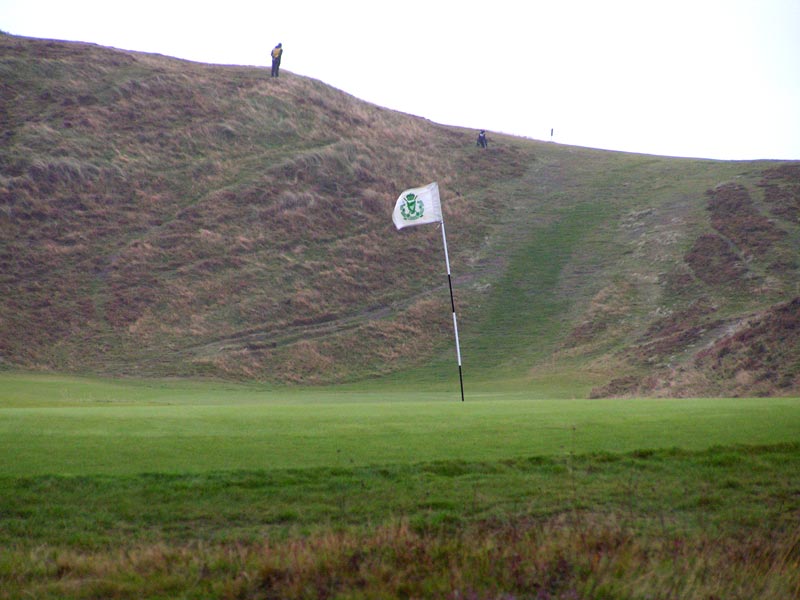
This view looking 250 yards back up the ninth hole highlights the epic nature of the hole that Colt created.
Harry Colt also brought the 11th green out of a hollow to its present position and relocated the 18th green to today’s position. Once again, Harry Colt‘s talent in building green complexes is much in evidence at the 18th as it appears as an extension of the fairway. In fact, it has sharp fall-offs on either side ala the 1st at Pine Valley Golf Club, making for many a testing recovery shot at the Home hole.
Harry Colt‘s reduction of blind approach shots coupled with the creation of several of the finest green complexes at County Down garnered high praise from all quarters. Like any links though, there were still changes to come, as now hickory clubs were being replaced by steel ones. First, the 12th green was moved back fifty yards and then after World War II, the 15th green was moved a similar distance back as well, creating the last of the world class holes that County Down enjoys.
Other than the continuing creation of back tees that now has County Down well over 7,000 yards, the final significant change to the course occurred in 2005 when the 16th was modified by Donald Steel into its present version. The new hole, infinitely more attractive than the old one, has good playing characteristics, as we see below.
Holes to Note
First hole, 540/505 yards; Voted by GOLF Magazine among the three finest opening holes in the game, the 1st has been in play in its current form for over one hundred years. Playing along side Dundrum Bay, a tee ball down the right can bring the sunken green in reach in two. The more one plays the course, the more one realizes how important it is to get off to a good start. The next three shotter isn’t until the 12th and the demand for quality golf is so high over the next ten holes, that a poor start weighs heavy upon the golfer.

On a course famed for its difficulty, the view back down the first shows the fairway to be in a natural valley that helps to collect either of the golfer’s first two shots, a fine attribute for a first hole. After this benevolent start, the challenge steadily increases.
Second hole, 445/385 yards; A course renowned today for its blind shots, there once were many more blind shots, including the approach shot to this green. Work in the 1920s saw the dune 45 yards short of the green lowered, the green raised (especially in the back), and the fairway slightly raised as well. The dune was lowered in such a manner though that only approach shots in the middle portion of the fairway gain a decent look at the green. Approaches from tee balls missed wide left or right can still be blind, a very clever design feature that puts a premium on accurate driving. With a tee ball that must carry over a dune to a blind fairway and an approach that must carry over the dune pictured below, good hitting is required. The golfer appreciates that the topped or missed shots that will occasionally suffice at other links won’t do so here.

Thanks to work done to the dune shy of the green in the 1920s, the golfer in the middle section of the fairway gets a view of at least a portion of the second flag as well as some of the putting surface. However, as seen below, once the approach was not blind, requirements for accuracy increased.

One result of the second green being built up is that recovery shots from either side of the green are among the trickiest on the course.
Third hole, 475/455 yards; This hole stands side by side with the third at The Country Club in Brookline and the 3rd at National Golf Links of America as the author’s favorite 3rd in the world. Its great attribute is that there is no clearly defined ‘best’ way to play it. A long drive down the right of the fairway leaves the shortest approach but the shot is blind. A drive long down the left gives the golfer the best view of the green, though at the expense of a longer approach. With trouble both left and right, other golfers prefer the center line off the tee as at least some of the flag might be visible. Golfers play this hole for years before deciding a preferred course of action.

A view down the long third from the tee benched into the dune. Dunes on both sides squeeze the fairway 140 to 60 yards from the green and these natural landforms were used to great effect in creating different playing strategies.
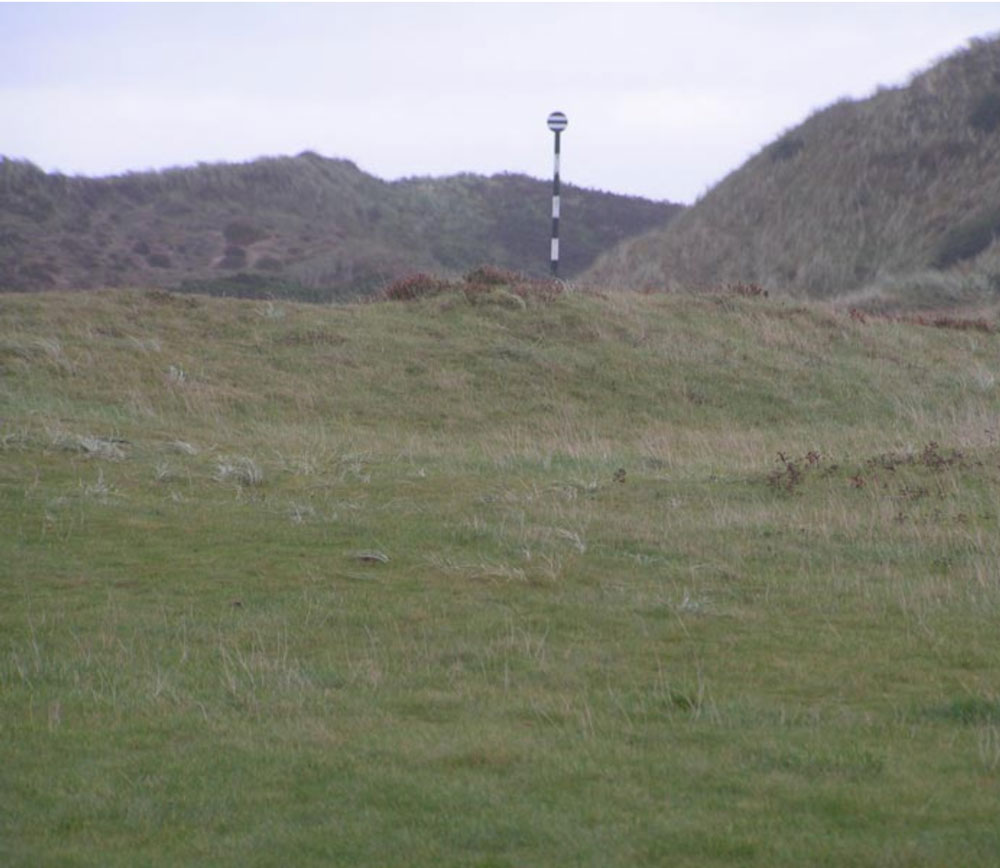
A tee ball hit long down the right yields this view for one’s approach.
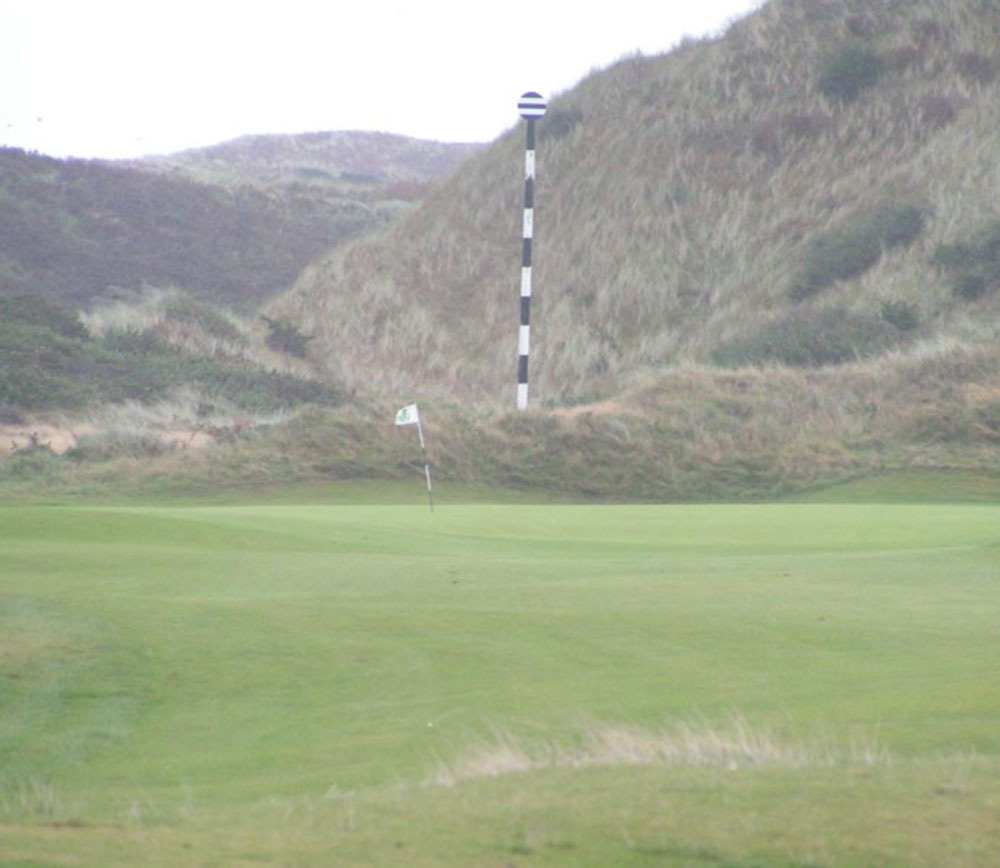
The ideal tee ball is long down the left, yielding this view.
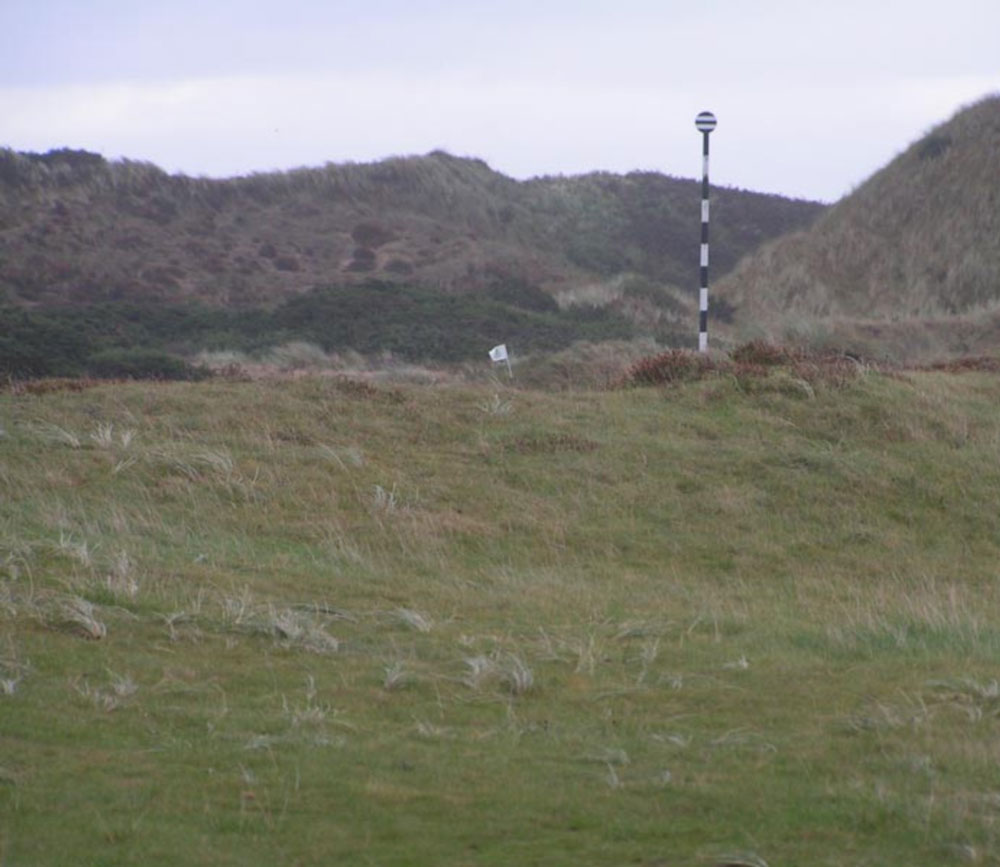
Of course, heather and gorse are down the left of the fairway. Tom Paul likens playing County Down to playing Oakmont because of their shared high demand; architecture. As such, some golfers opt to play down the center line, yeilding the partial view of the flag as seen above.
Fourth hole, 215/175 yards; Harry Colt’s hole, and the finest one shotter on the course, not because of the famous view over the links and toward the Mountains of Mourne, but because of Harry Colt’s green complex.

The view from the elevated back markers at the fourth: a 200 plus yeard one shotter over a sea of gorse to a green….

…ringed with difficult shots, be it from gorse, heather, bunkers or the tightly mown swale around the green.
Fifth hole, 440/410 yards; The golfer is given every opportunity not to play well at County Down as the design does more to disconcert the golfer than any other course with which the author is familiar. Though the blind tee balls on the 2nd and 11th are more confrontational than here, the diagonal playing angle for this blind tee shot creates more confusion. The length of the hole means that the player dearly loves to shorten it with a bold drive but the hidden fairway, gorse and five (!) bunkers guarding the inside of the dogleg suggest not.

The classic symbol at County Down: a white stone marking the way off the tee.

Once around the bend at the dogleg right fifth, the sight of the green opens up to the golfer. Dogleg holes in windy sites force the golfer to account for the wind from two different directions on the same hole, a good thing.

The backdrops to the greens at County Down are the equal of those that have long been heralded at the Cypress Point Club. As with many approach shots, when in doubt at County Down, the miss is often straight and short.
Sixth hole, 400/360 yards; As at Pine Valley Golf Club, the golfer at some point takes for granted the number of world class holes that he is playing. Thus, a hole like the 6th rarely gets the attention that it deserves. Elsewhere, it would be a standout short/medium length hole. Though the blind drive provides no comfort, the test is the approach shot to a domed green that falls away on all sides. Already the smallest putting surface on the course, its sloping sides give the golfer an effective hitting ara of little more than 2,000 square feet – and even less when it’s windy.
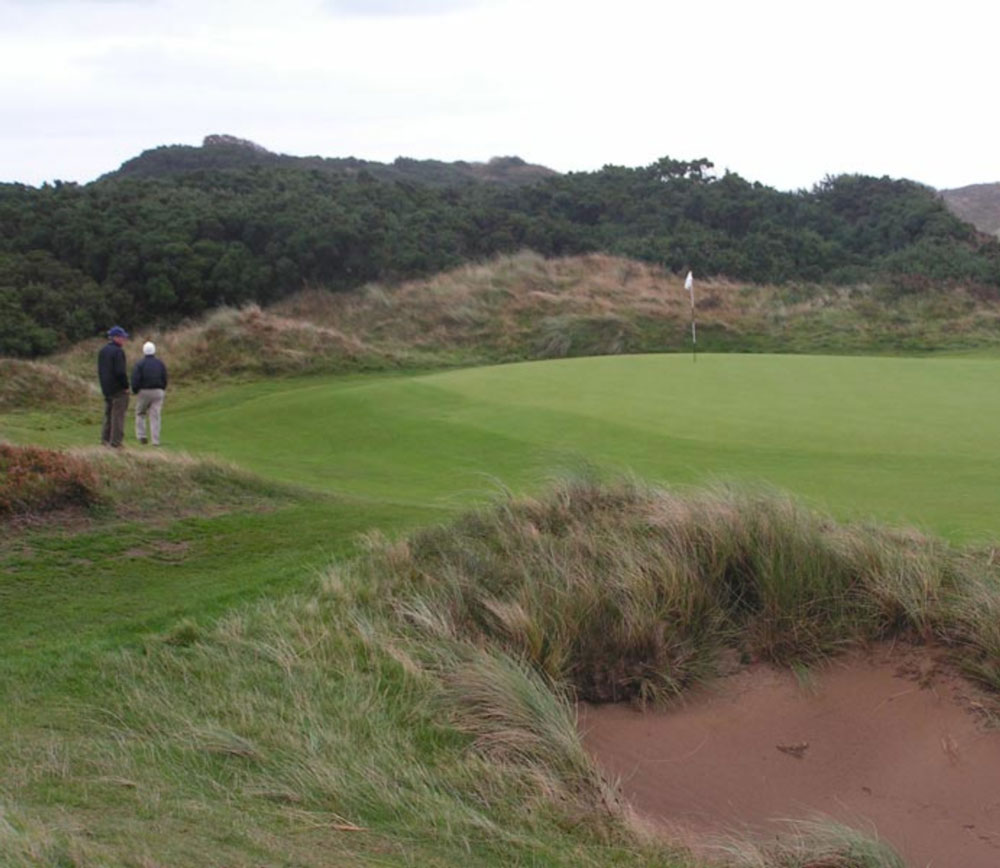
After the big hitting that is required on the second through the fifth holes, the golfer needs o be quick to realize that the tiny sixth green holds its own perils.
Seventh hole, 145/125 yards; A maddeningly hole to play, the golfer at this point in his round is thinking surely he is better than his score indicates. The short 7th is the perfect place to right the ship and yet, like the 6th, it features one of the most severe greens on the course with its left quarter sloping off and toward the deepest greenside bunker on the course. A right to left wind can, tragically, make this one of the day’s most difficult holes.

A nice crisp pitch and a birdie awaits? Perhaps, but the reality is that some balls that land on the green are also feed left and down into a deep pit.
Eighth hole, 430/415 yards; Though Colt deserves credit for keeping this hole on top of the dune, his green site was actually just past the two bunkers that are 75 yards short of today’s green. Wilson Smyth, the Captain of the Club, who largely took over for Combe in 1915 moved the green to its present location, thus creating one of the toughest two shotters in the world. The Centenary Book offers this superb quote: Smyth Eoeruled the Club with a rod of iron for the last twenty-five years of his life and for ten years after his death.’ (!!) The point cannot be stated clearly enough: the credit for County Down’s great design resets largely within its membership.

A view from the tee of the long and demanding two shot 8th hold. Colt’s original green site is just past the last two bunkers in the photograph above.

Wilson Smyth moved Colt’s green (which would have been in the foreground above) back to today’s current location. Though the eight green may appear free of trouble, the first timer soon learns otherwise.

This view from left to Smyth’s green location shows it to be both more exciting and dangerous than Colt’s as it features this precipice to the left. Having the worse trouble hidden from view wears on the better golfer.
Ninth hole, 485/430 yards; The dramatic sixty foot drop 200 yards from the back 9th tee markers is – in theory – actually too sharp for good golf. And that makes Colt’s routing over this dramatic landscape all of the more impressive as the hole works wonderfully well. Once again, the golfer is given something to accomplish that no other course does on quite the same scale – launch a tee ball over the top of a dune to a blind fairway well below. The thrill of a well struck tee ball is immense but infrequent. Indeed, the key to one’s round at Country Down is often how well the payer recovers from a missed tee ball. Far too often, a missed shot results in a double bogey or worse as the golfer gets greedy with his recovery shot. Interestingly enough, golfers frequently display worse judgment on harder courses than on the easier ones. County Down ruthlessly exposes such unsound and impatient course management. The 9th is a prime example: not to be on the wide fairway in two with a pitch to the green for an easy bogey is inexcusable but somehow, doubles and worse are more the norm. The 9th hole highlights a term that readily applies to County Down: ‘appropriate blindness.’ The golfer has a wider margin of error for his (blind) tee ball with tighter requirements following for the (non-blind) approach.

Standing on the ninth tee, the golfer is left with the disconcerting feeling of hitting his tee ball over the dune and into oblivion.

From the summit, the ninth plunges sixty feet to a forty yard wide level fairway.

Colt altered the dune, thus affording the golfer a good look at the green. Before his visit, the green was in approximately the same place but was a blind one shotter. The bunkers pictured above are 35 yards shy of the putting surface and make laying up problematic from a missed tee ball.
Tenth hole, 195/180 yards; Like the 1st, this hole was a natural with a green situated in a natural amphitheater of dunes. As such, it has remained in play for at least one hundred years. In fact, this green may well have been in use over one hundred and fifteen years as it may be the 2nd green from Old Tom Morris’s original layout.

Tucked at the base of the dunes, evidence suggests that this may have been one of Old Tom Morris’s greens. Note the fearsome must go up and over the dune.
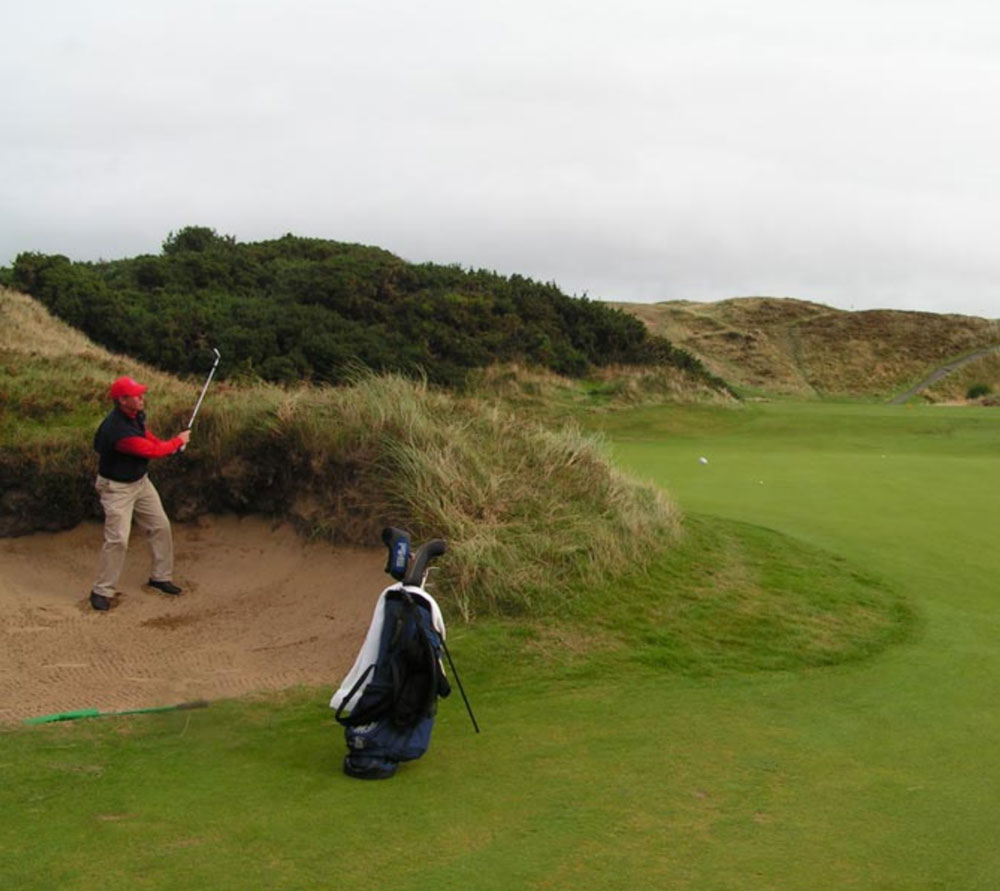
The tussock faced bunker left of the 10th putting surface presents the need for a talented recovery shot. The 60 degrees wedge is imagine playing County Down in the 1920’s – the niblick had the most loft, making County Down’s bunkers all the more fierce.
Eleventh hole, 440/430 yards; Modern golf course architecture has evolved into a much more strategic form than it was at the turn of the 20th century. Yet, there is too much of a good thing and today’s architects are less willing to utilize fronting hazards with which the golfer must contend. At the 11th, the golfer simply must get away one of his best drives of the day, up and over the forty foot dune directly in front of him. More so than any other course with which the author is familiar, good driving at Country Down does further to assist the golfer play to his handicap. The beautiful sweep of the fairway just over the crest of the dune is a fine example of how Combe integrated a natural landform into the design.
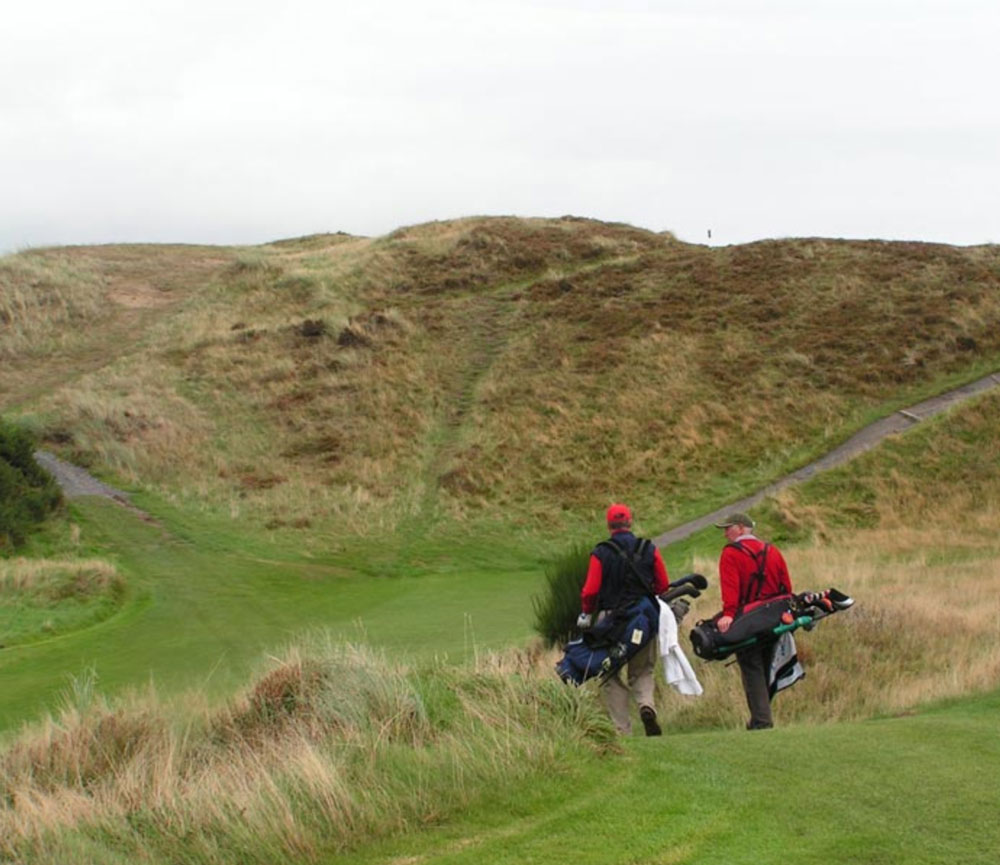
Welcome to County Down – the view from teh 11th tee.
Twelfth hole, 525/470 yards; As witnessed each spring at Augusta National Golf Club, give and take is crucial to good golf architecture. The golfer has to have the opportunity to make up some lost ground. Otherwise, the round becomes one of attrition, which is not golf at its exhilarating best. Far more interesting to present the golfer with chances for heroic deeds and put pressure on the golfer to recognize when he should best strike. The 12th and the new 16th are both such holes. As they play in opposite directions, one generally affords the chance to play aggressively and reach the green ahead of regulation.
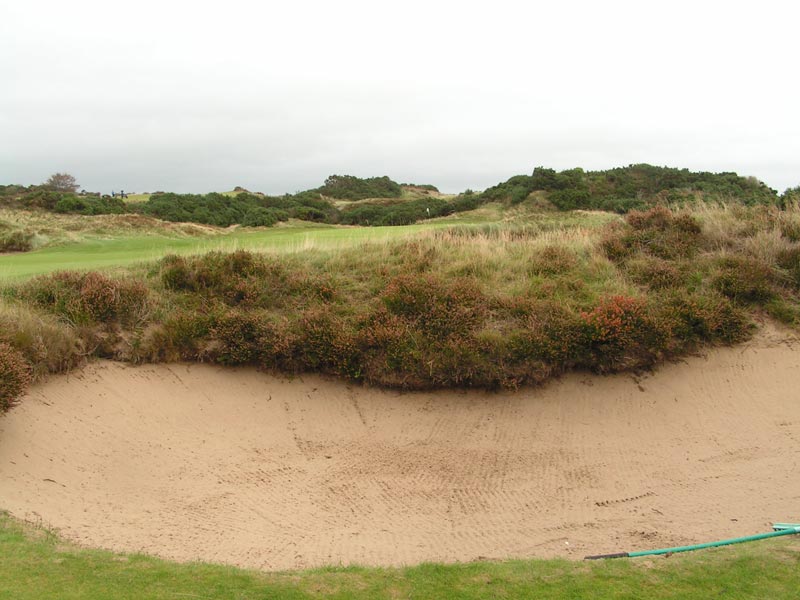
The bunkers at County Down are generally considered the most handsome in the game due to their variety, both in size and in the unkempt vegetation that grows on their faces. More importantly, the bunkers are well placed. This one at the 12th is 90 yards from the green and makes laying up problematic when the hole is played into the wind.

A view just over the bunker pictured above, looking back down the graceful twelft fairway. The fairway steps down 165 yards from the green. Such is the wind and firm playing conditions at County Down that a drive downwind might take that slope and leave the golfer with but a short iron into this three shotter.
Thirteenth hole, 445/420 yards; The favorite hole of many a member, this natural hole twists its way through a gorse covered valley. The approach shot is deceiving. Playing over the gorse and bunker infested ridge, the player may be able to just see the left edge of the green or at least the left greenside bunker. For fear of the unknown, the golfer is tempted to play toward what he can see. This tendency steers him toward the trouble on the left. However, there is a good amount of fairway short and well right of the green. Only after many rounds does the golfer trust his memory and play his approach down the right side over the most fearsome trouble. The green is severely sloped and makes par a struggle to the very end. A decade after Royal County Down opened, Garden G. Smith penned his wonderful (but hard to find) book, The World of Golf. He observed that ‘A hole should always give one the impression that it owes its existence to its own intrinsic merits, to its individuality and character, and not, as too often happens, to the fact that it had to be there because, foresooth, there was no other place to put it.’ He may well have been thinking of County Down when he wrote this as so many of its holes are absolutely unique unto themselves with the 13th being a particular highlight.

A view from the seventh tee shows the thirteenth fairway running through a valley between hills covered in weather and gorse. Can the golfer on the tee go long left with his tee ball to get a clear view of the green? Or is he best to lay-up near the base of the dune on the right…
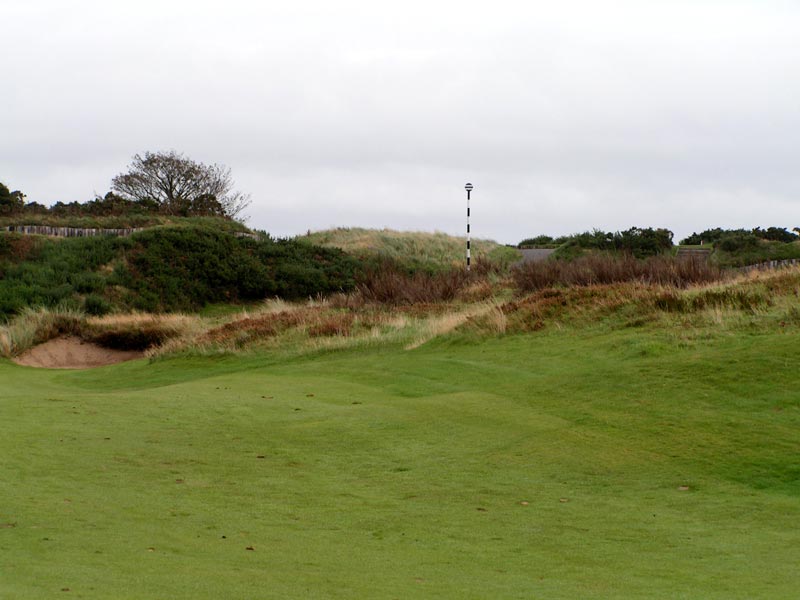
…and be content with this blind approach?A view from behind the 13th green shows the room to the golfer’s right of the green that can be used to bounce his approach onto the sloping green.
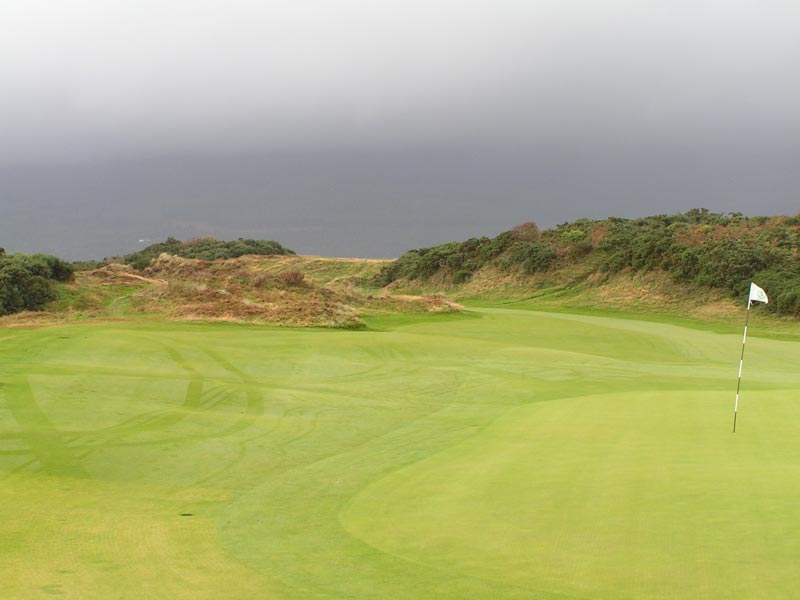
A view from behind the 13th green shows the room to the golfer’s right of the green that can be used to bounce his approach onto the sloping green.
Fourteenth hole, 210/200 yards; The direction that one shot holes face only matters in windy locations. In this case, Newcastle is a windy location and this hole is the only hole/shoton the course which points away from Dundrum Bay. Following in the time honored tradition of so many of the finest, older links, the green follows the general slope of its surrounds. In this case, that’s from high front right to lower left. The golfer is free to use the short grass above the green to work the ball onto the putting surface.

The 14th hole rests easy upon the land, a great compliment.
Fifteenth hole, 465/455 yards; The author disagrees with Sir Peter Allen this one time: this two shotter is harder than the great thirteenth at Pine Valley. At Pine Valley, the approach shot is encouraged to bounce onto the green from the right. Not so at County Down with this shelf green shrugging balls to either side.
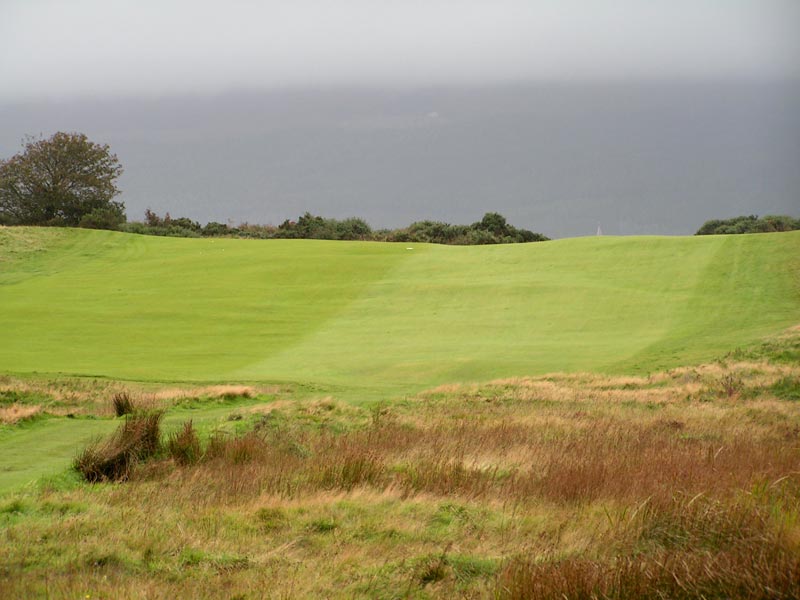
A good drive sees the golfer reach the crest of the hill at the 15th and from there…

…the golfer faces a long iron approach over broken ground to a green that…

…is an extension of the fairway but that falls away on both sides. Into much wind, the golfer may wisely lay-up 10 to 20 yards shy of the green and rely on a chip and a putt for par.
Sixteenth hole, 335/300 yards; As one member puts it, this has all the makings of a good hole. Certainly a more handsome hole than its predecessor, Donald Steel created this hole in 2005. Played from an elevated tee, the green is still in reach for the tiger golfer, which was the lasting attribute of the old 16th. The new green slopes from front left to back right, a feature much admired by the author for a hole of this length as it means that the golfer who plays the hole with little thought or care may well find himself in the “dead zone:” a fifty or sixty yard pitch with little chance of spin to a green that runs away.

A view down the new 16th from the tee.
Seventeenth hole, 435/405 yards; An underappreciated hole, all because there is a natural pond blind from the tee that is 100 yards from the green. Under certain wind conditions, the tiger golfer can drive into the pond. Though completely natural as it is a low point where water collects, its appearance is so unusual on this, the mightiest of all links, that the pond is ever a lighting rod for criticism. Thus, the pond takes away from the hole’s two finest playing characteristics: the approach is almost always played from a sloping stance and its gathering green complex featuring hard-to-read interior contours is among the finest on the course.

This back bunker is one of three bunkers that rings the gathering 17th green.
Eighteenth hole, 550 yards/530 yards; Fittingly for a course famed for its bunkers, there are eighteen of them down the Home hole. The hole is too long for the golfer to steer his ball and he needs to keep swinging out. The demands of Colt’s shelf green means that the golfer wants to advance his ball as far as possible in two shots. Colt’s green makes the hole and the course a test to the very end.

As with the 1st green at Pine Valley Golf Club, the 18th green at County Down is an extension of the fairway with sharp fall-offs on either side. Coming into this green with a long club for one’s third is unlikely to end the round in a satisfactory manner.
The front nine is either the best or among the best in the game. Detractors of County Down, of which there are but few, weakly claim the back nine is a let down. The front nine occupies the prime area by the bay and the back nine lesser so – that much is true. However, the back nine suffers only in direct comparison to the front nine. The 13th and 15th holes are among the handful of finest holes on the course. The Home hole might be the most testing three shotter in Northern Ireland. The one shotters at ~200 yards require sturdy hitting. Indeed, the back at County Down more than holds its own against the back of the Dunluce Course at Royal Portrush. Yet, no ones seems to hold the back nine at Portrush to the same impossibly high standards that they do to the back at County Down. Much has been written about the setting of Royal County Down with none doing it justice. Please note: the pictures in this course profile where taken on a cold rainy day in October – just imagine the course in the spring with the gorse in bloom and long shadows playing across the course. Peter Dobereiner may have come close to County Down’s beauty when he wrote ËœThe links of Newcastle are exhilarating even without a club in your hand’ and Bernard Darwin too when he penned that the golf at Newcastle is’ the kind of golf that people play in their most ecstatic dreams.’ Add in its unmatched challenge by any other links and one may well conclude that he has just played the finest course in the world.
The End

